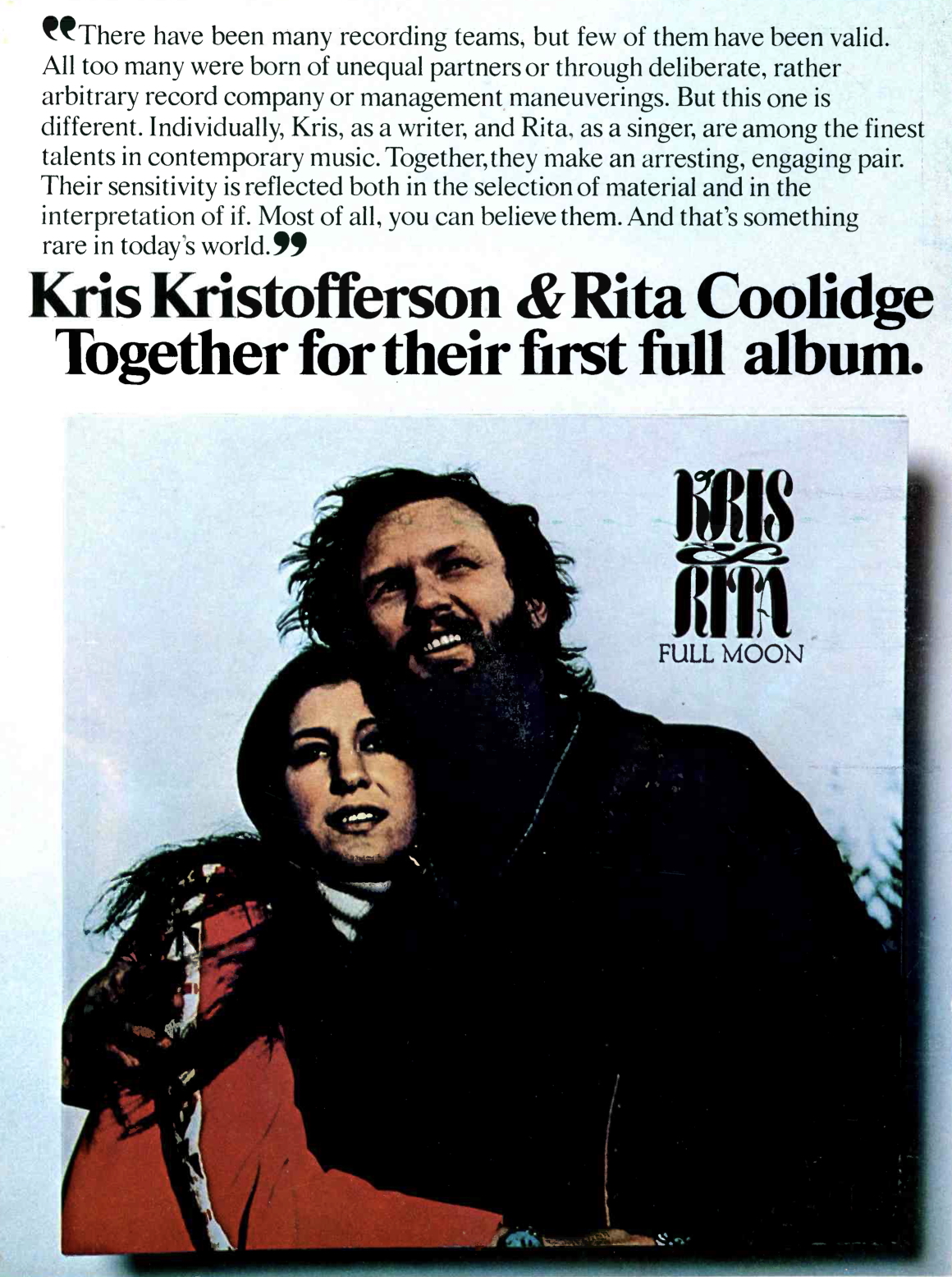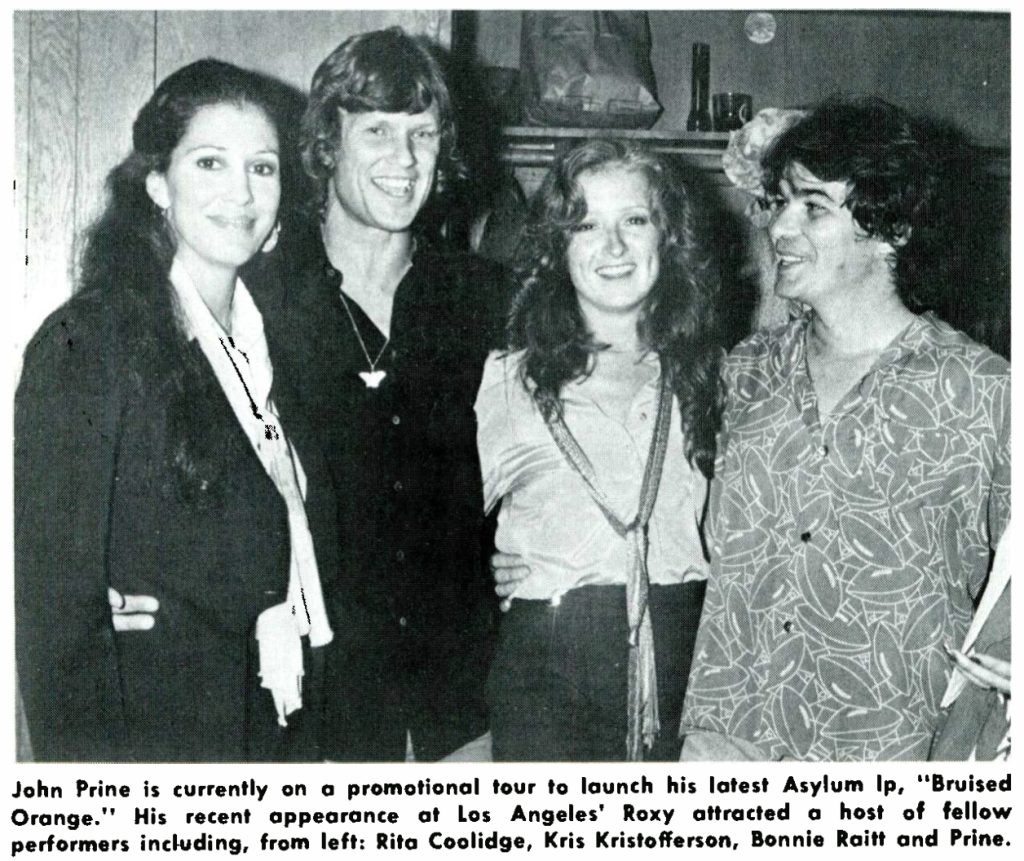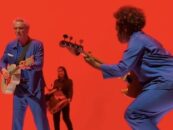Kris Kristofferson & Rita Coolidge: ‘Full Moon’ and In Harmony
by Mark Leviton
This ad for the album appeared on the back cover of the Sept. 29, 1973 issue of Record World.
If Kris Kristofferson and Rita Coolidge’s creative partnership and marriage were the basis for a romantic comedy screenplay, their first encounter in 1970 would be the “meet cute” scene.
Kristofferson was the celebrated songwriter and performer, whose life had included time as a Rhodes Scholar studying literature at Oxford University, and hustling his tunes while working as a janitor in Nashville. Coolidge was the “go-to” backing vocalist for Joe Cocker and many others, who’d been dubbed “Delta Lady” by the Mad Dogs and Englishmen tour’s music director Leon Russell, who had also written a song about her. Coolidge’s Cherokee heritage and striking talent made her a charismatic beauty that drew male musicians to her, with both positive and negative effects.
“It was really strange the way I met Rita,” Kristofferson told Rosalind Russell of Disc magazine in 1972. “I was flying to Nashville from L.A. and I was late for the plane, and we met at the ticket counter. We got talking, and we talked on the plane, and so I got off at Memphis with her. At first we just worked with our own bands, doing guest spots on each other’s shows, but we really got into working together at a concert in Copenhagen [April 1, 1972].”
They were married August 19, 1973, and released the duet album, Full Moon, a month later on September 19. Looking back on the album decades later for Uncut magazine, Kristofferson recalled, “I think it was probably my idea. I love singing with people anyway, and I loved to sing with Rita together in harmony. I grew up with the Everly Brothers, harmony was always something I loved, and Rita sang backup with people all the time. Harmony came easily for both of us, it was very natural. The songs were more or less what we felt we wanted to do and what the producer David Aderle felt we could do well. It was a very different thing to what I was used to. [Rita and I] worked well together at first, and it hadn’t gotten to where we were fighting—yet.”
Recorded at Sunset Sound in Los Angeles with engineering by veteran John Haeny, the album was released under Coolidge’s contract with A&M Records, after it was agreed Kristofferson’s label Monument would get the next duet set. Full Moon was a hit, reaching #1 on the Billboard Country Albums chart, and earning a Grammy for Best Country Vocal Performance by a Duo or Group at the 1974 awards ceremony, honoring the single written by Kristofferson, “From the Bottle to the Bottom.”

Coolidge and Kristofferson (at left) with friends Bonnie Raitt and John Prine (Photo from Record World magazine, 1978.)
Musicians who previously worked with the vocalists, including guitarist Stephen Bruton, keyboardists Donnie Fritts and Mike Utley, and drummer Sammy Creason, contributed again. Booker T. Jones (who was married to Rita’s sister Priscilla) also came by. Anderle had produced all three of Coolidge’s A&M releases, including her most recent The Lady’s Not for Sale, and his connections to the cream of L.A. session players meant bassist Leland Sklar and percussionist Bobbye Hall could be included. And rounding out the family feeling, A&M co-owner Herb Alpert fell by to add a trumpet part.
The LP begins with “Hard To Be Friends,” written by Larry Murray, who’d been in the L.A. band Hearts & Flowers with future Eagles founder Bernie Leadon, and written “Bugler,” a tune the Byrds featured on their album Farther Along. Starting with a slow ballad is normally an audacious move, but as soon as Coolidge begins singing, the listener is drawn in, even before Kristofferson’s quiet harmony enters: “Is it so hard to be friends/When it was so easy to be lovers?” Although the album’s liner doesn’t credit musicians for specific individual contributions, that’s probably Josh Graves’ Dobro and David Bromberg on steel guitar, adding color to the perfectly calibrated arrangement.
The melancholy “It’s All Over (All Over Again)” is a Coolidge-Kristofferson co-write that recalls any number of George Jones-Tammy Wynette duets: “Let’s take a chance while there’s something to say/Oh darling, don’t throw it away/We know that we’ve both got so much to lose/And the rest of our lifetime to pay.” Kristofferson is called upon to suppress his usual gruff speak-sing style and carry a real melody, and as he does on all of Full Moon, he transforms his approach to fit his singing partner’s better-developed vocal abilities. It sounds like Bruton’s keening electric guitar supplying the final notes.
“I Never Had It So Good,” written by Paul Williams and Roger Nichols, had been part of Williams’ 1971 A&M album Just an Old Fashioned Love Song. Coolidge leads it with aplomb, with the seductive softness she can bring to her voice without loss of focus. Kristofferson in support is exactly right. It sounds like Booker T. is handling the crucial organ part, and there are terrific electric and acoustic piano parts too, so kudos to all the keyboardists. The final 45 seconds are dramatic, and the loudest moments on the album.
Billy Walker first recorded Kristofferson’s “From the Bottle to the Bottom” for Monument in late 1968, and got to #20 on the Billboard country singles listing, but Kristofferson didn’t include the tune on any of his own albums when his career moved from behind-the-scenes songwriter to performer. (A rare version he cut appears on The Essential Kris Kristofferson compilation.)
It’s a jaunty novelty tune that chronicles, in highly-sculpted language, the life of a homeless man who reminds the singer of himself: “Did you ever see a down-and-outer waking up alone/Without a blanket on to keep him from the dew?/When the water from the weeds has soaked the papers/He’s been putting in his shoes/To keep the ground from coming through?” As with Kristofferson’s famous line, “Freedom’s just another word for nothing left to lose,” ambiguity is built into the attitude of the singer of the song: “You wonder if I’m better off/With freedom now to do the things I choose/Well, all my time’s my own/And I got nothing left but sleeping time to lose.”
Full Moon’s first upbeat number finds Kristofferson throwing himself headlong into his performance, while Coolidge, entering at 1:42, sounds decidedly uncomfortable with the fast tempo, although she recovers. The arrangement throws everything in, from Jerry McGee’s harmonica to Vassar Clements’ fiddle. When the mostly pop label A&M promoted the Full Moon version to country radio like it was a new song, it got plenty of airtime.
Tony Joe White cut “Take Time to Love,” a song he wrote with Donnie Fritts, for his The Train I’m On album in 1972, and it proves excellent as adapted for Rita and Kris, cushioned by a lush orchestral arrangement from David Campbell (Beck’s dad) and Norman Kurban. This might be the best vocal pairing on the album, with Kristofferson’s baritone and Coolidge’s mezzo-soprano finding an emotional center, even with simple lyrics that don’t give them much to work with: “We’ve got to take some time for understanding/On that long and winding road back to love/Let’s don’t let our story have a sad ending/We got to take the time to love.”
Bobby Charles’ “Tennessee Blues” has been covered dozens of times over the years since it first appeared on the veteran Louisiana songwriter’s self-titled 1972 Bearsville album. Kristofferson and Coolidge might also have been thinking of Tracy Nelson’s heart-wrenching version with the group Mother Earth from ’72 when tackling it for Full Moon. Kristofferson softens his voice to a near-whisper, but has some trouble with pitch—when Coolidge enters for the second verse she elevates the track beautifully. An electric guitar played through a Leslie speaker, Dobro and accordion (Nick DeCaro) are part of a delicate arrangement that justifies “Tennessee Blues” being the album’s longest track.
“Part of Your Life” was written by the country singer Charlie Rich’s son Allan and Allan’s mother Margaret, and was first recorded for Allan’s debut Epic Records LP. Coolidge and Kristofferson perform it fine, but don’t especially connect with it’s easy-listening pop sensibility, no matter how countryfied the instrumental arrangement tries to be. “I’m Down (But I Keep Falling),” written by Kris and Rita, is a strong showcase for Coolidge, who might have made it soar higher without having to accommodate her husband.
Written by the rather obscure Canadian songwriter Hod Pharis, “I Heard the Bluebirds Sing” was a hit in 1957 by the Browns, but had been cut by the author five years earlier without commercial success. Full Moon’s full-out bluegrass version has a peppy, traditional call-and-response vocal arrangement, buttressed by Clements’ fiddle, Randy Scruggs’ guitar, and the killer Josh Graves Dobro once more. It’s a delightfully swinging change of pace.
Stephen Bruton wrote the casual-tempo, bluesy “After the Fact,” and plays electric lead guitar on it. Coolidge gets the opportunity to overdub herself to create a lovely backing choir, and the whole track has a slow-burning quality, with both Kris and Rita totally committed, their voices intertwining exquisitely. It makes you yearn for an entire Coolidge/Kristofferson blues album.
Unfortunately, the LP peters out with the final substandard tracks. The duo got first crack at Tom Jans’ “Loving Arms,” but when released as a single it stalled at #86. The arrangement is one of the album’s few misfires. Dobie Gray did much better when he issued his version as the follow-up to his “Drift Away” smash. Kristofferson’s solo composition “A Song I’d Like to Sing” also failed as a single release. The Caribbean arrangement, with Bobbye Hall’s xylophone prominent, tries to create a party that can’t be enjoyed even when Alpert adds his trumpet solo. If Kristofferson was trying to be Jimmy Buffett, he failed.
Kristofferson and Coolidge’s daughter was born in 1974, and Rita miscarried a second child in 1977. To hear Coolidge tell it in her 2016 memoir Delta Lady [available here], her marriage was already doomed (they divorced in 1980). Kristofferson could be emotionally abusive, especially when he’d been drinking heavily, although the physical abuse she’d endured from her previous boyfriend, the drummer Jim Gordon, was on another level: “The incidents were very different,” she told No Depression magazine. “Kris was drunk and whirled around and struck me when I was trying to help him walk down the hall. He didn’t know until the next day, when he saw my black eye, that he had hit me, and he was very apologetic. Even so, no woman should be hit.”
Kris Kristofferson died Sept. 28, 2024, at the age of 88. Safe in the Arms of Time, Coolidge’s most recent album, arrived in 2018. [Her recordings are available in the U.S. here and in Canada here.] She apparently has no plans to tour or record, although as she wrote in her book, “I’m still here and I still have a lot of gratitude for the whole process of being able to make music…Maybe I’ll leave the music business, but I’ll never stop being a singer.”
Kristofferson’s recordings are available in the U.S. here and in Canada here.
Bonus Video: Watch Kristofferson and Coolidge perform live on The Flip Wilson Show in 1972
Related: What were the top-selling albums of 1973?
- Smokey Robinson & the Miracles’ ‘Going to a Go-Go’: Life of the Party - 11/11/2025
- Patti Smith’s ‘Horses’: Poetry In Motion - 11/10/2025
- Rockpile’s ‘Seconds of Pleasure’: One And Done - 11/08/2025






1 Comment so far
Jump into a conversationIt is very irritating to see the author take Coolidge’s version of the marriage to Kristofferson at face value. She is not exactly a neutral party. I think a more balanced view of that marriage will be written someday by a biographer. Kristofferson did not write a memoir, and he never publicly commented on Coolidge’s book..